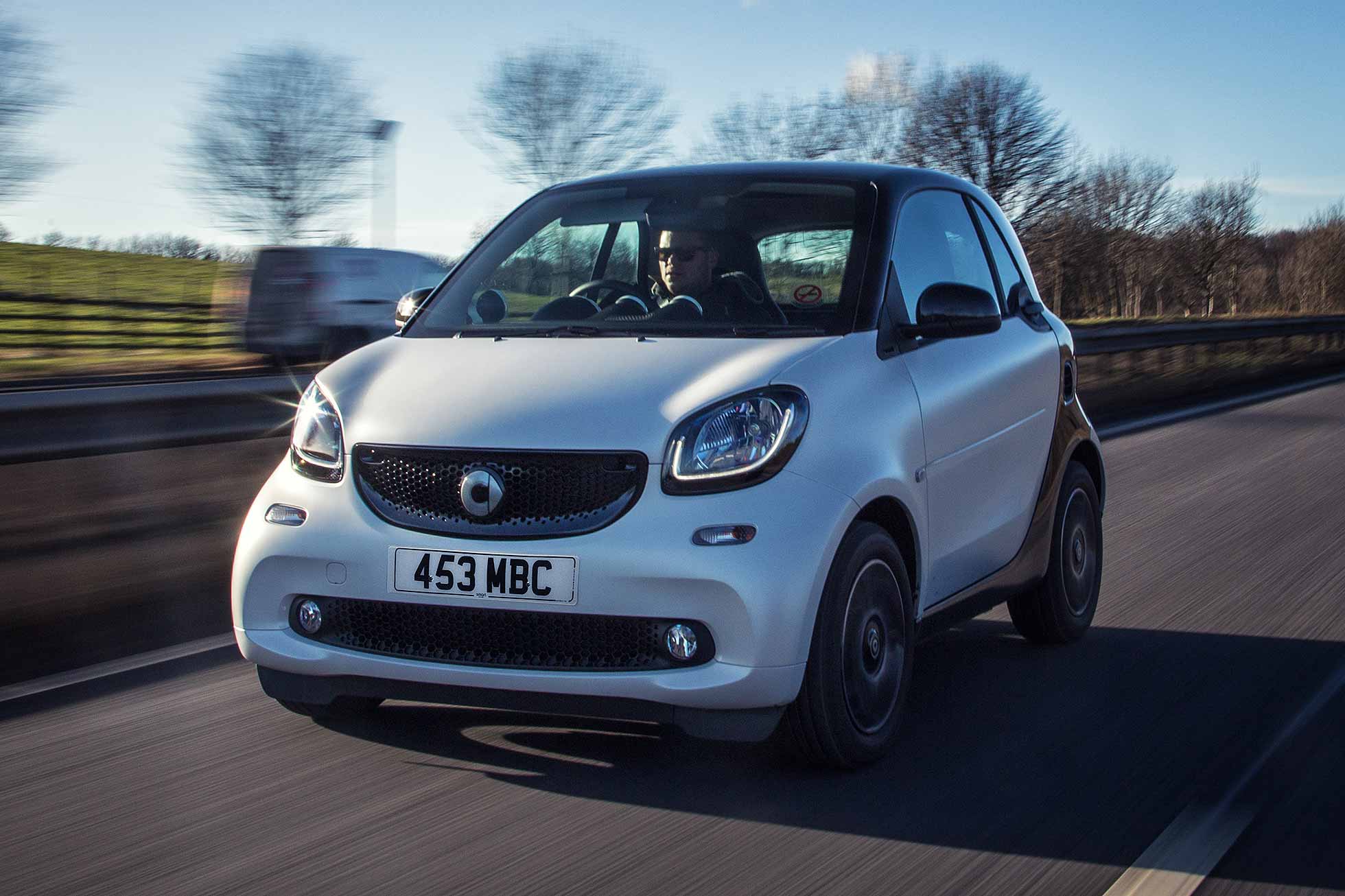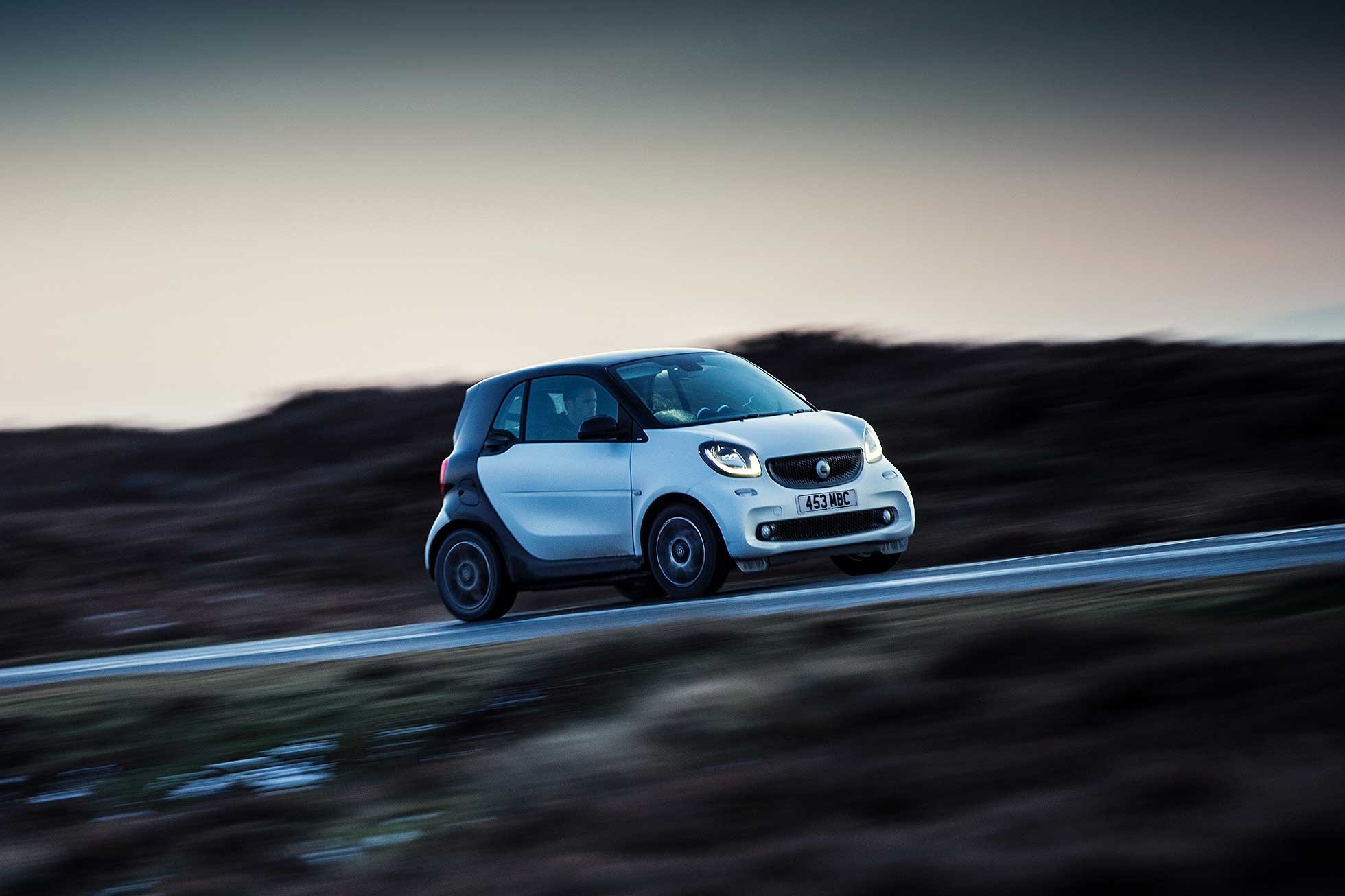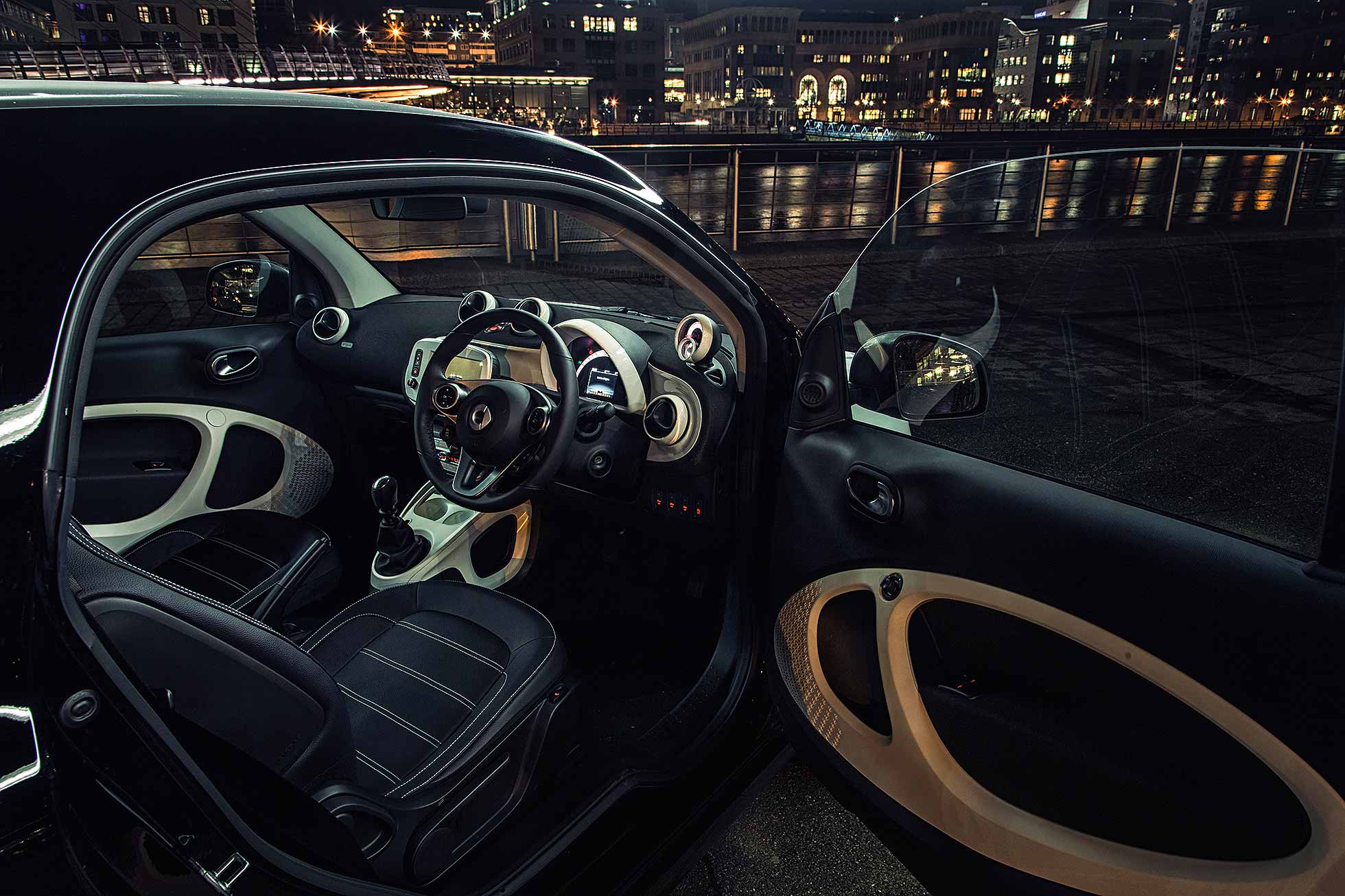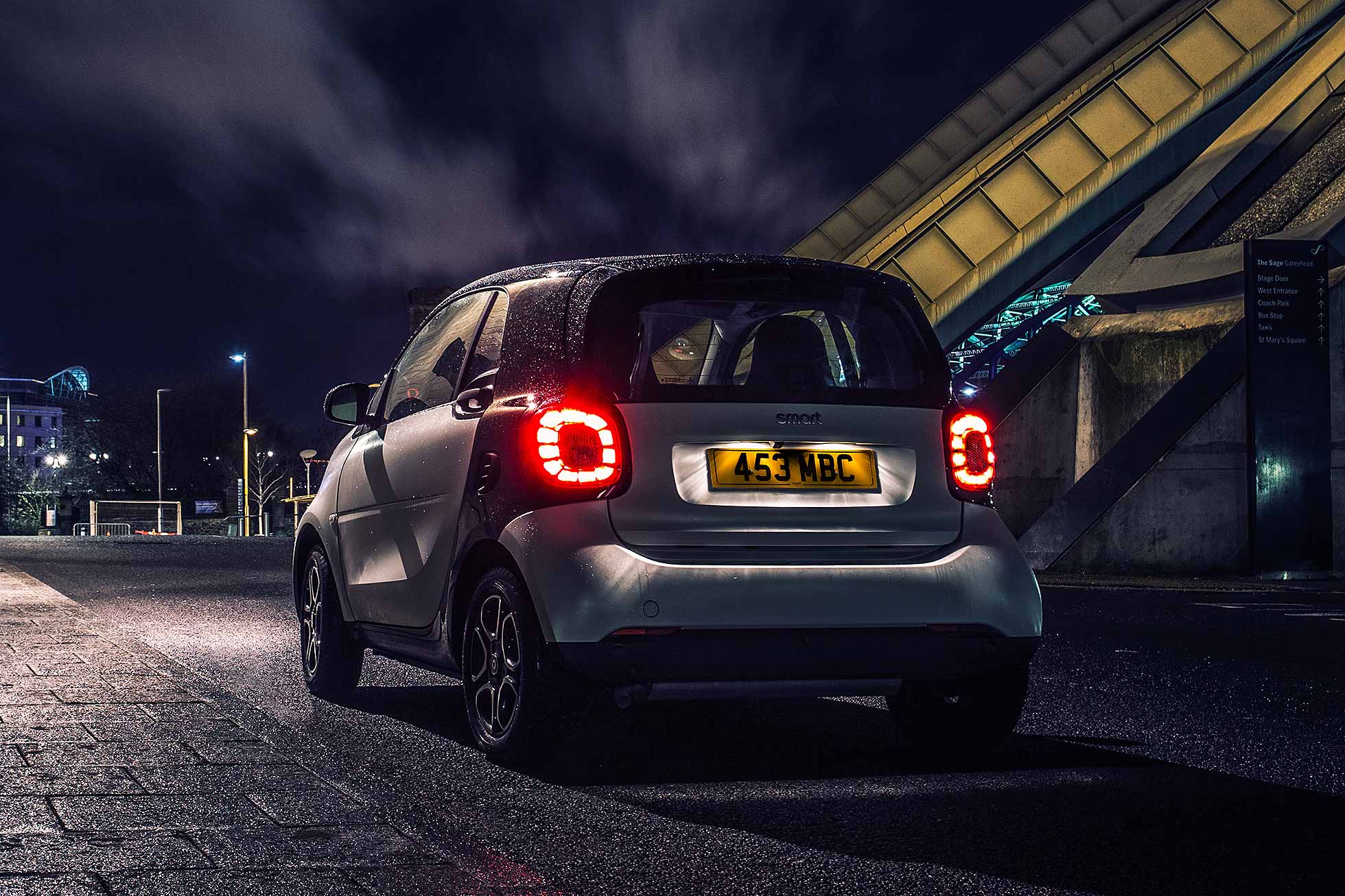 Smart at last; the most distinctive of all city cars has been transformed
Smart at last; the most distinctive of all city cars has been transformed
Richard Aucock | February 2015
Here’s an eye-opening fact: Smart has been on sale in the UK for 15 years now. Admittedly, the first few years were left-hand drive imports, but right-hand drive cars soon followed and today, with more than 100,000 sold here, it’s a familiar sight.
But in all that time, it’s always been imperfect. The first ones fell over when it was windy (allegedly); standard ESP soon dealt with that, but the cart-like suspension wasn’t so easily fixed. In a decade and a half, no Smart has ever ridden well, changed gear smoothly or been particularly nice to use outside the city environment it was designed for.
Third time lucky with this all-new one, then. Co-developing it with Renault has capped the cost of the bits below, but not compromised what’s on top. Indeed, a design target was to keep the 2,695mm length of the original, allowing it to park nose-in to the kerb. To the millimeter, this was met (but not without tireless engineering to overcome the design challenges…).
The Smart also has a nose for the first time. This has riled purists but it’s inevitable, says Smart: the car’s so short, adding crush space at the front is the only way to meet ever-stricter pedestrian legislation (and an amazing crash test with a Mercedes-Benz S-Class suggests prioritising this is perhaps no bad thing).
It means the cabin is a bit shorter than it was, so seats are no longer staggered. So to provide sufficient elbowroom, the Fortwo’s now wider – and you can bet stability is enhanced by the wider track, too.
What’s the 2015 Smart Fortwo like to drive?

The Fortwo now drives like a proper car and is immeasurably more appealing as a result. First biggie: the ride is far more compliant, with long-travel suspension allowing bumps to fully be absorbed for the first time in the car’s history.
You feel this from the off, in the lack of city-centre skittishness and sense of hopping from one bump to the next. You’ll no longer wince and brace yourself at the sight of broken surfaces, and high-speed smash-crashes are almost totally eradicated.
It’s still a touch high-frequency and choppy at times – an inevitability of the short wheelbase – but it’s much less nervous and frenetic, and you can now actually feel springs and dampers working as you’d hope. Indeed, press on and it shows premium car depths of ability (maybe no surprise given Smart’s claim the front suspension design draws from the Mercedes-Benz C-Class).
A more composed ride delivers more confident handling. You don’t hold on and hope for the best, but can now use the car’s sub-900kg kerbweight, light front end and grippy rear-drive, rear-engine balance to your advantage. Steering is light and pure (just the merest hint of electric assistance), accuracy is impressive and while it’s hardly MINI-like in purity, it’s surprisingly good fun to steer quickly.
You’ll have to work the non-turbo 71hp 1.0-litre three-cylinder engine hard to summon such speed, though. A throbby, slightly shuddery unit at low revs, it lacks the low-rev torque we’ve become used to these days, feeling more sluggish than you’d expect such a light car to be.
It’s better with revs – much quicker, much smoother – and it will sing at 4,000rpm-plus all day long. So make good use of the other huge Smart advance, a five-speed manual gearbox: the smoothness is now in your hands rather than an electronic clutch, comfort swelling accordingly. The shift is light, snappy and direct, feel benefitting from the close-set rear-mounted location.
Smart hasn’t lost the old car’s amazing turning circle, either. It’s way less than a London Taxi, for heaven’s sake – time and again the car’s sheer maneuverability will amaze you and onlookers. Only this time, stability out of city limits doesn’t appear to have suffered as a result.
Is the 2015 Smart Fortwo finally a compromise-free city car?

Before, the benefits of the city-friendly Smart came with compromises in comfort, confidence and capability. Owners suffered for their art, particularly if they strayed outside the city. While not fully eradicated, the new Fortwo can finally be considered a regular driver, even for those who aren’t totally city-bound.
Indeed, in many ways, it’s now the genuine junior Mercedes-Benz we always hoped (rather like MINI is a convincing city BMW, in fact). New, more premium styling helps – it’s less top-heavy than it was – but it’s the interior that really moves the Smart on.
The old one was always good quality; this is even more so, despite the scattering of Renault-derived switchgear. Displays, surface finishing and overall appearance bears scrutiny alongside the latest C-Class, particularly the smart new sat nav touchscreen interface, and apparently endless customisation will keep buyers occupied for hours.
It’s well equipped, too. A Smart costs around £2,000 more than a Renault Twingo; the difference is all the Daimler engineering, extra soundproofing, Mercedes-Benz-spec testing and so on, but also standard equipment that sees even the base Passion boast climate control, cruise control, alloys, five airbags and multi-function steering wheel.
Smart has entered the modern era in another way too: all models now come with standard power steering…
It does have its limits. Crosswind-correcting ESP is new but the occasional gust will still remind you it’s tall and short. There’s more ‘grey’ background noise than in regular cars, and the engine sitting just centimetres behind you is ever-present, albeit sweet and eager (pity about the stop-start off and on supers – oh, and the screechy starter noise). The boot is bigger but still small, and you still have to give the long doors a tug to shut the, cleanly first time.
But now, it’s only really at first you sense the short, sit-high smart is something different. Learn to trust it, discover the newfound depth and you just may find it fits into life as a daily driver pretty well – it’s certainly leagues ahead of the old car and now really does feel like a car you’d expect Mercedes-Benz to deliver.
Verdict: Smart Fortwo 1.0 71

The new Smart Fortwo is a big step on. It needed to be: the old ones had novelty but sore limitations that made the premium price hard to swallow. This one addresses them without hurting the character too much, and while retaining the ultra-short distinctiveness that made so many people fall for Smart in the first place.
Yes, it’s still expensive for a 71hp city two-seater, but this time it had the depth and substance to justify it. A conventional car like an Up will always be the better all-rounder but there remains nothing like the Fortwo, which now delivers cute character without asking you to be too blinkered about the rest of it.
Rivals: Smart Fortwo 1.0 71
- Volkswagen Up
- MINI Hatch
- Hyundai i10
- Kia Picanto
- Suzuki Celerio
The clever Up is now rightly familiar and remains the most imaginative City car o there (trade badge for cash with Skoda and SEAT). MINI takes the premium city car route, trading budget practicality for junior BMW status – it’s dear, but the Smart isn’t so cheap either. Hyundai and Kia are sensible-shoes able and the Suzuki is startling value for money and brilliantly space efficient, although saddled at the moment by a worrying braking issue…
Specification: Smart Fortwo 1.0 71
Engine: 1.0-litre three-cylinder
Gearbox: Five-speed manual
Price from: £11,820 (1.0 71 Prime)
Power: 71hp
Torque: 67lb ft
0-62mph: 14.4 seconds
Top speed: 94mph
MPG: 68.9
CO2: 93g/km
ALSO READ
Honda CR-V review: 2015 first drive